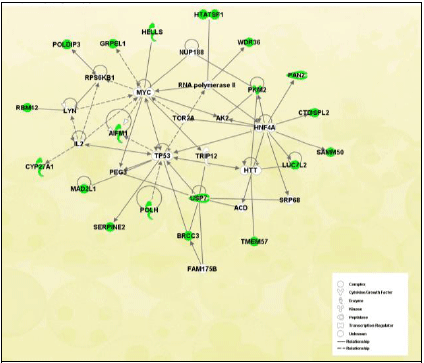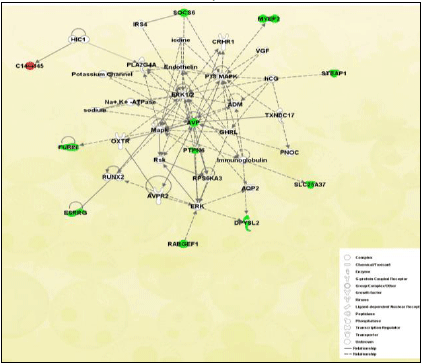



Impacts of <em>Salmonella Enteritidis</em> Infection on Liver Transcriptome in Broilers
The pathways revealed in their study help to determine the systemic effects of Salmonella infection, which may lead to genome-directed methods of disease control in poultry, write Derrick Coble, Erin Sandford, Tieming Ji and Professor Susan J. Lamont, in Iowa State University Animal Industry Report 2012.Summary and Implications
Salmonella is a bacterium that can infect chickens, contaminating meat and eggs, resulting in production losses and illness in consumers.
This study was designed to analyze the metabolic effects of Salmonella infection in broilers. Livers were harvested from broilers at ten days post-infection with Salmonella. RNA was isolated and then transformed into cDNA. Genes were analyzed on a global level using microarray technology.
Among the differentially expressed genes with known function, gene expression of 29 out of 30 genes was lower in Salmonella-challenged birds than non-challenged birds. Genes associated with the cell cycle along with DNA replication, recombination, and repair functions were the most significantly differentially expressed genes. Salmonella infection resulted in reduced expression of genes involved in cell death, protein recycling, blood pressure increase, cell proliferation, extracellular kinase activation and suppression of immune signalling.
The revealed pathways help to determine the systemic effects of Salmonella infection, which may lead to genome-directed methods of disease control in poultry.
Introduction
Salmonella is a gram–negative bacterium, which results in production losses and illness in consumers. Salmonella infection can occur in the egg or after hatch. Contamination of eggs occurs through maternal exposure in infected hens or contact with faecal material from infected chickens. Transmission in chickens can occur through environmental factors such as infected faecal material, air, litter, unclean facilities and vectors, such as rodents and humans.
Once the chicken is infected, Salmonella colonises the intestines and spreads throughout the body, reaching the liver and spleen within a day of infection. Bacterial infections can have generalised impacts on physiology. Salmonella infection results in a reduction in feeding, reduced body weights, and malnutrition. Malnutrition and metabolic disease both can lead to fatty liver pathology in chickens.
Although several studies have determined the effects of Salmonella infection on expression of immune genes and the associated gene networks in chickens, less is known about how Salmonella infection affects genes and gene networks involved in general metabolic processes.
The objective of this study is to provide insight into the systemic metabolic effects of Salmonella infection in broilers.
Materials and Methods
The samples
Broiler hens of approximately five months were used. All birds were determined to be free of Salmonella before the study began. Eight birds were challenged orally with Salmonella, and eight were mock-challenged. Livers were harvested 10 days after infection.
Microarray analysis
Total RNA was isolated from each liver sample. RNA samples were purified, labelled and hybridised to a 44k microarray. After hybridisation, gene expression was analysed.
Quantitative real time PCR validation
The expression levels of eight genes differentially expressed by microarray were analysed in triplicate by qRT-PCR. The adjusted cycle threshold (Ct) value of each sample was analysed using ANOVA and JMP 8.0.2 software.
Results and Discussion
Forty-four genes were differentially expressed in response to Salmonella. At a suggestive level, 183 genes were differentially expressed in response to Salmonella. Among the genes with known function, there was a predominant trend of reduced gene expression in response to Salmonella (gene expression was higher in 29 of 30 genes in the challenged birds). Two gene networks were created using pathway analysis. One network involved cell morphology, cell cycle, organismal injury and abnormalities genes (Figure 1) and the other network involved metabolic disease, cardiovascular system development and function, and urological disease genes (Figure 2).


Genes associated with the cell cycle along with DNA replication, recombination, and repair functions were the most significantly differentially expressed genes (Figure 3). Salmonella infection resulted in a reduction in expression of genes involved in cell death, protein recycling, blood pressure increase, protein precursor activation, activation of extracellular-regulated kinase activation and suppression of immune signaling. The 8 most differentially expressed genes were confirmed by PCR analysis.

The reduced expression of four genes (a gene involved in cell death, a cell cycle checkpoint gene and two genes that are responsible for the breakdown of recycling of proteins) from the ‘Cell Morphology, Cell Cycle, Organismal Injury and Abnormalities’ network and a gene involved in antibody production from the ‘Metabolic Disease, Cardiovascular System Development and Function, and Urological Disease’ network reflects a suppression of the immune system of broilers by Salmonella.
The reduced expression of four genes (an electron carrier; a gene responsible for binding damaged DNA, metal ions, and zinc ions; a gene involved in a metabolic pathway that converts glucose to pyruvate and responsible for binding ATP, magnesium ions, potassium ions; and a gene involved in binding unfolded proteins) from the ‘Cell Morphology, Cell Cycle, Organismal Injury and Abnormalities’ network and four genes from the ‘Metabolic Disease, Cardiovascular System Development and Function, and Urological Disease’ network (a gene involved in cell differentiation and development, a cleavage enzyme involved in cell proliferation, a solute carrier, and a gene involved in the transport of molecules across membranes) reflect a host immune response to reduce Salmonella proliferation and growth.
The reduced expression of a gene which is involved in vein constriction reflects a host mechanism to reduce the inflammation that accompanies Salmonella infection. The reduced expression of a gene that suppresses immune signaling reflects a host response to reduce inflammation associated with Salmonella infection.
In conclusion, the effects of Salmonella infection on genes and gene networks associated with the metabolism of broilers reflects host-pathogen interactions are marked by Salmonella suppressing the immune response of broilers and broilers suppressing genes responsible for cell growth, cell proliferation, vein constriction and cytokine suppression.
Further Reading
| - | You can view other reports in the ISU Animal Industry Report 2012 by clicking here. |
February 2012








